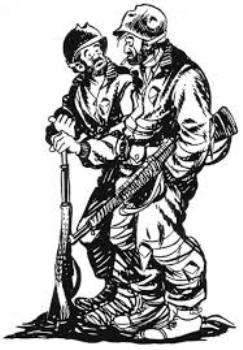Willie and Joe

Willie and Joe are stock characters representing United States infantry soldiers during World War II. They were created and drawn by American cartoonist Bill Mauldin from 1940 until 1946. He occasionally added additional drawings until 1998. They were published in a gag cartoon format.
History
Mauldin was an 18-year-old soldier training with the 45th Infantry Division in 1940. He cartooned part-time for the camp newspaper. Near the end of 1941 the Japanese attacked Pearl Harbor, and the USA entered World War II. Mauldin was sent to combat, influencing his cartoons. They gradually became darker and more realistic in their depiction of the weariness of the enduring miseries of war.[1] He extended the bristles on their faces and the eyes – "too old for those young bodies", as Mauldin put it[1] – showed how much Willie and Joe suffered. In most cartoons, they were shown in the rain, mud, and other dire conditions, while they contemplated the whole situation.[2]
While Mauldin was praised for his realistic depictions of what most soldiers felt during war-time, he was less popular with some officers. General George S. Patton, Jr. in particular felt offended by the cartoons.[1] Mauldin was ordered to meet him in March 1945 in Patton's quarters in Luxembourg, where Patton complained about the scruffiness of the characters and blamed Mauldin for disrespecting the army and "trying to incite a mutiny".[3] But Dwight Eisenhower, Supreme Commander European Theater, told Patton to leave Mauldin alone, because he felt that Mauldin's cartoons gave the soldiers an outlet for their frustrations. The War Department supported their syndication.[4] The cartoons helped publicize the ground forces and showed the grim side of war, demonstrating that victory would require repeated sacrifices.[5]
Stephen Ambrose, author of Band of Brothers, praised Mauldin's work: "More than anyone else, save only Ernie Pyle, he caught the trials and travails of the GI. For anyone who wants to know what it was like to be an infantryman in World War II, this is the place to start – and finish."
Publication history
The cartoons were published in the 45th Division News from 1940 until November 1943, when the Mediterranenean edition of the Stars and Stripes took them over. In early 1944, Mauldin's editor arranged for syndication by United Feature Service as Up Front. As of 1945, according to a Time report, the cartoons were published in 139 newspapers.[6]
Mauldin received two Pulitzer Prizes for cartooning, one in 1945 and one in 1959. By the end of the war, he also received the Army's Legion of Merit for his cartoons. Mauldin planned for Willie and Joe to be killed on the last day of combat, but Stars and Stripes staff dissuaded him. He tried to bring them into civilian life, but could not find a successful way to do that. He discusses this in his memoir, Back Home, in 1947.[7]
Mauldin occasionally drew new cartoons of "Willie and Joe" after the war. He drew them to commemorate the funerals of people he admired, such as generals Omar Bradley and George C. Marshall and fellow cartoonist Milton Caniff.
Mauldin retired in 1991 and drew the pair for the final time in 1998, as part of a Veterans Day strip for the popular comic Peanuts. Its creator, Charles M. Schulz, was a personal friend of his. Schulz considered Mauldin a hero of his own.[8]
Availability
In March 2008, most World War II comics by Mauldin were published in a collected Fantagraphics Books edition.[1][2]
Legacy
The films Up Front (1951) and Back at the Front (1952) were based on Mauldin's Willie and Joe characters; however, when Mauldin's suggestions were ignored in favor of making a slapstick comedy, he returned his advising fee; he said he had never seen the result.
"Willie and Joe" were satirized as "Billie and Moe" by Warren Sattler in National Lampoon Presents The Very Large Book of Comical Funnies.
On Veterans' Day 1998, Willie and Joe appeared in the comic strip Peanuts in a strip that Mauldin drew with Charles M. Schulz.
On March 31, 2010, the United States Post Office released a first-class denomination "$0.44" postage stamp in Mauldin's honor depicting him with Willie & Joe.[9]
Original Willie & Joe comics and other illustrations by Bill Mauldin are in the collections of the Pritzker Military Museum & Library.
Sources
- 1 2 3 4 "Willie & Joe: The World War II Years by Bill Mauldin". Fantagraphics.
- 1 2 "For 'Willie & Joe,' War Is Hellishly Real — And Funny".
- ↑ "Mauldin at War, 1943–1945".
- ↑ Bill Mauldin, edited by Todd DePastino, Willie & Joe: The War Years, p. 13, ISBN 978-1-56097-838-1
- ↑ Bill Mauldin, edited by Todd DePastino, Willie & Joe: The War Years, p. 15, ISBN 978-1-56097-838-1
- ↑ Debra Ramsay. American Media and the Memory of World War II. Routledge, 2015. ISBN 1317617908.
- ↑ Gallagher, Matt (12 January 2016). "The Greatest Generation Wasn't Always That Great".
- ↑ Charles Schulz. "Peanuts Comic Strip, November 11, 1998 on GoComics.com". GoComics.
- ↑ "USPS News Release: 2010 Stamp Program Unveiled". 6 June 2011. Archived from the original on 6 June 2011.